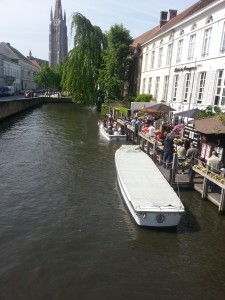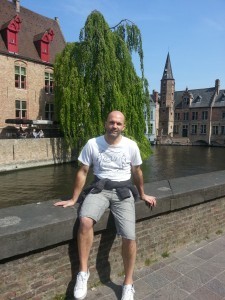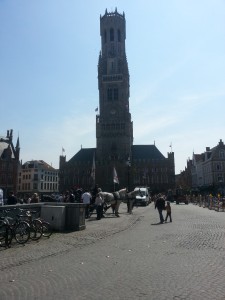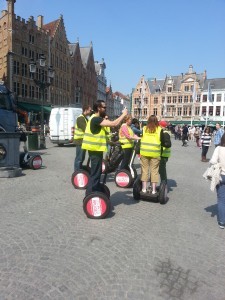A guide to Bruges- If you’ve not been you will do soon.
If you’ve cruised the likelihood is you have been to Bruges, the likelihood is that you will go to Bruges again.
Are you like me, just get off the ship and go explore? Well below is a detailed description of what Bruges has to offer, please read and don’t miss out on some hidden gems.
It sounds obvious but make a note of which berth your cruise ship is docked! The cruise ship will dock in Zeebrugge and will normally berth along the Leopold II dam or in the Albert II docks, located in the western port and about 1 mile from the ‘Zeebrugge-Strand’ railway station. The general advice is to get a transfer to Blankenburg – a small town about 10 – 15 minutes away by coach or car. From here it is easy to get the train to Bruges – a one-way ticket is quite reasonable and trains usually run once an hour. The station is then about a 10 minute walk from the city centre. Although, it might be easier to take a taxi into the city – there are always plenty at the cruise terminals.
If you make your way to t’ Zand square you will find the Tourist Information Centre on the bottom floor of the concert hall. Here you can pick up a ‘combi-5 ticket’ that will give you access into many of the museums at a reduced rate. The official language in Bruges is Flemish (Dutch), most people speak English pretty well but just in case here are a few key phrases:-
| Hello – Good Morning | Hallo – Goedemorgen |
| Goodbye | Tot ziens or Dag |
| Yes – No | Ja – Nee |
| Please | Alstublieft |
| Thank you (very much) | Dank U (wel) |
| Excuse me? Sorry | Pardon |
| Do you speak English? | Spreek je Engels? or spreekt u Engels |
| I don’t understand | Ik begrijp het niet |
| Where is? | Waar is? |
| Left/Right – Straight On | Links/Rechsaf – Rechtdoor |
| Train – Bus – Taxi – Ship | Trein – Bus – Taxi – Boot |
| I’d like a ticket | Ik wil graag een |
| One-way – Return | Enkele reis – Heen en Terug |
| Where is the toilet, please? | Waar is het toilet alstublieft? |
| How much? | Hoeveel kost? |
| Could I have the bill, please? | Mag ik afrekenen, alstublieft. |
Shopping, Eating & Getting Around
The main shopping streets are situated between Markt square and the old city gates. Most shops are open between 9am and 6pm, with late-night shopping on Fridays. Other than chocolate, Bruges is also a great place to buy hand-made lace and if you do want to pick up one or two of those famous beers remember each beer will have its own unique glass that you can buy to go with it.
Walking round Bruges is fairly easy-going. It’s flat and virtually traffic free but if you want to explore the city in comfort and style you could take a mini-coach which has panoramic windows. A sightseeing tour usually lasts just under an hour and leaves from the Markt square. Equally there are the horse-drawn carriage rides, again leaving from the Markt Square. You can normally take four people for around the same price as a mini-coach tour. Or if you really want to ‘push the boat out’ you could see Bruges from the relaxing confines of a canal boat. Starting points are from either Mariastraat, Nieuwstraat, Huidevettersplein, Wollestraat or Dijver and prices are again very reasonable.
If you stop to have something to eat in Bruges tips are optional and are usually factored into the bill although it’s worth noting if you need the loo you will need to pay the person who sits at the entrance to a toilette. He or she has a plate where you put your money. There are no public toilets, most are privately owned.
And finally should you need to contact the emergency services dial 101 for police or 100 for fire or an ambulance. From mobile phones The E.E.C. emergency number is 112.
Time Zone here is Central European Time
Bruges gets its name from the Vikings in the 9th century who called it ‘Brygga’, which means landing place. By the Middle Ages Bruges was a wealthy port with merchants descending from all over the world to trade goods. Canals and waterways had to be regularly adapted to allow the large trade ships to reach the city. In the 1300s, when the House of Burgundy declared Bruges one of its favourite residences, the city began to flourish, with overseas travellers coming to buy a variety of luxury goods. Although this good fortune was not to last! The unexpected death of Mary of Burgundy in 1482 and the revolt against her widower, Maximillian of Austria, meant Bruges quickly deteriorated and the Burgundian court left; taking their wealth and foreign interest with them. During the following centuries Bruges was affected by successive occupations from Austria, France and Holland, and by the time Belgium became an independent country in 1830 Bruges was classed as the poorest city in Belgium. Thankfully the 20thcentury breathed new life into the city, with medieval heritage and international tourism turning out to be a new source of wealth. And, in the year 2000, over 700 years of cultural and architectural treasures helped Bruges achieve its UNESCO World Heritage status.
Bruges can also boast being the first to achieve two things – becoming home to the world’s first stock exchange and being the place where Praline was invented, the homes of which can still be visited today.
Politically, Belgium is very similar to the UK in that the Prime Minister is the Head of Government and the Belgium King, currently Albert II, is the Head of State.
Key Attractions-
One of the main attractions in Bruges is ‘The Church Of Our Lady’. Built between the 13th and 15th centuries its 120m high spire can be seen from all around the city. It also houses the marble Michelangelo sculpture of the Madonna and Child – one of Michelangelo’s only sculptures to leave Italy during his lifetime.
Opposite the ‘The Church Of Our Lady’ is St.John’s Hospital (now Memling in Sint-Jan – Hospital Museum). It’s one of the oldest preserved hospital buildings in Europe, giving an impression of what life was really like in a medieval, hospital ward. Numerous pieces of furniture, silverwork and paintings evoke images of the care that took place there throughout the centuries. The Memling Museum is also contained in the complex. Hans Memling was considered was one of the great 15th century flemish primitives and many of his paintings ended up in the Hospital. Memling died in Bruges and was buried in the local St.Gilles church, although the reason for the hospital owning so many of his paintings is not truly known – local legend suggests he may have been a soldier in the Duke of Burgundy’s army and when he arrived severely wounded was taken care of by the sisters and brothers of the Hospital; to reward them he gave them some of his paintings.
If you want to see other Flemish works of art there’s the Groeningemuseum – a small but world-class gallery. It houses six centuries of Flemish and Belgian paintings and focuses mainly on works by painters who lived and worked in Bruges. The permanent collection includes paintings by early Flemish artists such as Jan Van Eyck and Hans Memling plus works by Gerard David, Hieronymus Bosch and, from more recent times, Paul Delvaux and Rene Magritte. An impressive collection for a museum of only 11 rooms.
Behind the ‘Church Of Our Lady’ is the ‘Gruuthuse’ house and museum, a home that used to belong to one of the richest families in the city and has now been transformed into a museum entirely given-over to a large collection of works of art. The old Flemish word ‘gruut’ means peeled barley or wheat – the main ingredient for beer-brewing in the Middle Ages. The lords of Bruges had the monopoly for the sale of this product and as such became very wealthy and powerful figures.
The Market Square or Grote Markt is right at the heart of the city and a great place for any tourist to start. It’s largely pedestrianised and is an excellent place to begin your tour of the city, whether that’s on-foot or from one of the many horse-and-carraige rides that start and finish in the square. The square is surounded by some very impressive and colourful architecture, not least the medieval bell tower, or Belfort, that dominates the skyline. Formerly it housed the city’s treasury and archives but now the 83 meter high building provides tourists, that make the effort to climb the 366 steps, with an unparalled panoramic view of the city.
When you come down from the tower you might want to reward yourself with something from one of the many cafes and restaurants that line the square and if you happen to be there on a Wednesday morning – and have enough stamina left over – the weekly market is a treat for local produce and crafts.
Finally if you want to escape all the hustle and bustle you can retreat to the Lake of Love or Minnewater. A stunning park and lake with plenty of swans and photo opportunites. A magical spot in all weathers, although it’s best to visit early in the day before it gets too busy.
Incidentally the swan is one of the symbols of Bruges. The legend behind its significance surrounds the execution of one of the town administrators in 1488. Pieter Lanchals was part of Maximilian of Austria’s court and his family coat of arms featured a white swan. Supposedly Maximilian punished Bruges by forcing them to keep swans on their lakes and canals as a constant reminder.
Must Sees:
You really can’t leave Bruges without visiting Choco-Story, a museum dedicated to everything chocolate, from its early history in the days of the Maya to how cocoa is transformed into chocolate and its associated health benefits!
And if you want to stick with an edible theme there’s the Frietmuseum – the world’s only museum dedicated to Belgian fries. It’s the first museum that shows the entire history, from the origin of the potato to the first fries. Interestingly the museum also focuses on Belgian fries in art!
And, being one of only five diamond museums in the world, perhaps it’s also worth visiting the Diamond Museum. After all the art of diamond polishing was invented in Bruges in the 15th century when a local goldsmith Lodewijk van Berquem invented a diamond polishing wheel. Infact every day at 12.15 a polishing demonstration is carried out in the workshop.
St. Saviour’s Cathedral is Bruges’ oldest parish church with some parts dating back to the 9th century, although a fire and various building work means a majority now stems from the 14th century. The range of styles and artefacts include late Gothic choir stalls, murals from the end of the 13th century and tapestries from the 18th century.
There is also the ‘Basilica of the Holy Blood’ which since 1149 has housed a fragment of cloth stained with, what is said to be the coagulated blood of Christ, wiped from his body after the crucifixion by Joseph of Arimathea. Legend says the holy cloth was brought to Bruges at the time of the Second Crusade by the Count of Flanders, Diederik van de Elzas, who received it from the Patriarch of Jerusalem. The relic is embedded in a rock-crystal vial, which itself is inside a small glass cylinder and is brought out regularly on Fridays for people to view and kiss
About Me

Hi, I'm Trevor Smith and I joined the travel industry in 2001 as a part time travel consultant. Over the years and as the industry took a grip of my career I have moved through the ranks. Going full time in 2002 I soon went into management, training and development.…
Read more



